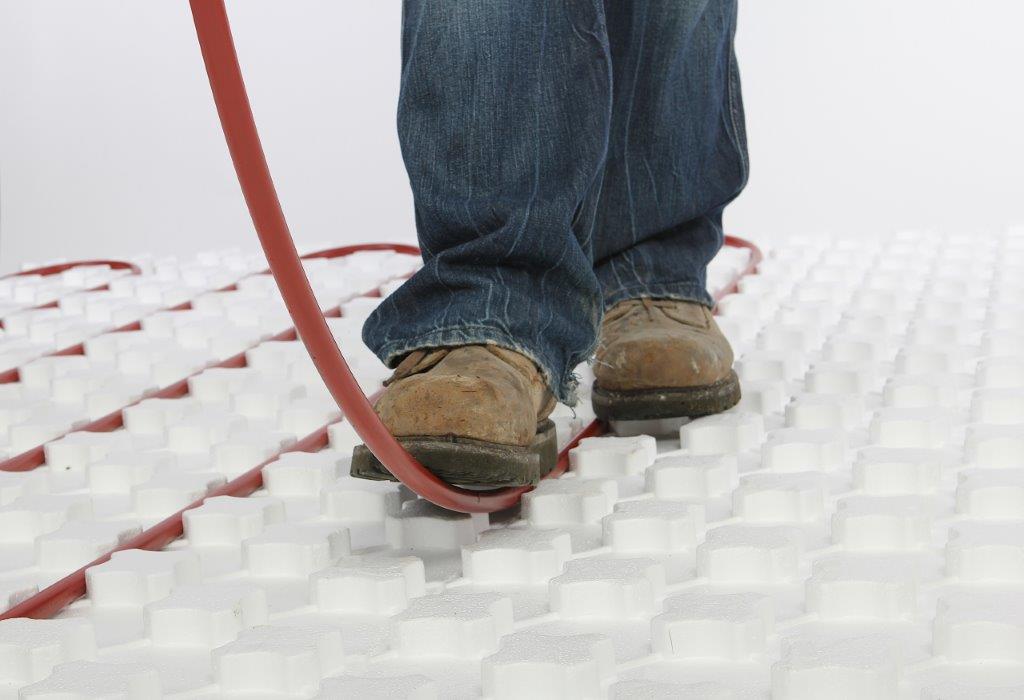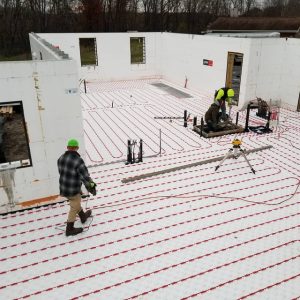
Don't miss a thing!
Subscribe for exclusive content, insider industry news and limited edition webcasts.
What are the pros and cons of radiant floor heating systems?
Radiant floor heating systems are becoming an increasingly popular choice as reported by Canadian Contractor. Here are some of the reasons why — and for a balanced perspective —a couple of the potential drawbacks:
 The Pros of Radiant Floor Heating Systems
The Pros of Radiant Floor Heating Systems
- Energy-Efficiency
One of the biggest benefits of radiant floor heating systems is their energy-efficiency, and there are a few reasons for their enhanced efficiency.
- They don’t have any duct work that would allow heat to escape.
- They only take roughly an hour to heat up and involve the use of a programmable thermostat, allowing homeowners to customize their temperature based on activity level. Even hydronic floor heating systems that typically work continuously still retain their heat.
- They work at much lower temperatures compared to traditional radiators.
- Lower Operating Costs
Running costs are low with radiant heating systems due to their duct-less design, which eliminates leakage and energy loss that is typical with forced air. There are virtually no maintenance costs either.
- Greater Comfort (Consistent Warmth)
Another big benefit of radiant floor systems is the high level of comfort they provide, particularly when it comes to consistent warmth.
The problem with forced air is that the HVAC system distributes hot air and then once the temperature drops, the process repeats itself, leaving temperature inconsistencies. Furthermore, since hot air rises, heat is distributed above your head instead of at a level that makes sense.
Radiant floor heating systems are also quieter and better for those with allergies — the latter being due to the combination of oxygen-rich air and minimal air movement (unlike forced air systems that distribute dust and other particles around as they provide heat).
- Longer Lasting
 Radiant floor heating systems are durable, outlasting most home furnaces. In fact, proper maintenance will ensure the mechanical components of the system, such as the boiler or manifolds, last up to 35 years. The R-Value of the Heat-Sheet panels and piping encased in the concrete floors should last indefinitely.
Radiant floor heating systems are durable, outlasting most home furnaces. In fact, proper maintenance will ensure the mechanical components of the system, such as the boiler or manifolds, last up to 35 years. The R-Value of the Heat-Sheet panels and piping encased in the concrete floors should last indefinitely.
- Easy & Quick Installation
As we discussed in this blog post, radiant floor heating systems are easy to install (with the right products, of course). The Heat-Sheet® Radiant Floor Panel, for instance, provides the under-slab insulation and makes the installation of the pex piping super-fast and easy. And its modules form a grid that allows you to simply “walk the tube into place”, usually with a minimum of ties or staples.
The Cons of Radiant Floor Heating Systems
While there are many more positives to radiant floor heating systems, there are a couple of cons to take note of:
- Higher Upfront Cost
Radiant floor heating systems typically have higher upfront costs with estimates being anywhere between $10.00 and $20.00 per square foot for labor and materials. An electrician will also be required to connect the system to a power supply. That said, these systems do pay for themselves over the long-term just as noted above.
- Slower Temperature Adjustments
It takes time for a high mass concrete slab to heat up or cool down. This means that making adjustments to the interior air temperature will take longer with a radiant floor heating system as compared to a forced air heating system.
- Flooring Must Be Replaced (retrofit applications only)
Radiant floor heating systems can be applied to both new and retrofit floors, but in the case of a retrofit application, they do require that the existing floor be replaced before the radiant heating can be installed (unless there is some way for the floor to be accessed from underneath between floor joists).
Wrapping It Up
While radiant floor heating systems do have higher upfront costs and require that the floor be replaced in retrofit applications, the pros tend to outweigh the negatives. From greater energy-efficiency to lower operating costs to enhanced comfort, it’s easy to see why more and more people are choosing radiant heat flooring systems.
Recommended Further Reading:
Request a quote, get more information, or talk to a Heat-Sheet® Advisor by contacting us today.
Sources:
https://www.bobvila.com/articles/the-pros-and-cons-of-radiant-heat/
https://www.realtor.com/advice/home-improvement/pros-cons-radiant-floor-heating/
https://sebringdesignbuild.com/your-guide-to-radiant-floor-heating-the-pros-and-cons/
https://www.warmlyyours.com/en-CA/posts/9-pros-and-cons-of-heated-floors

 The Pros of Radiant Floor Heating Systems
The Pros of Radiant Floor Heating Systems




